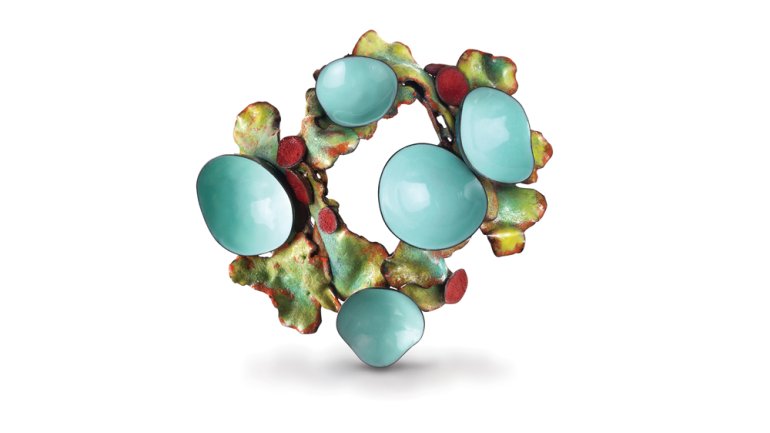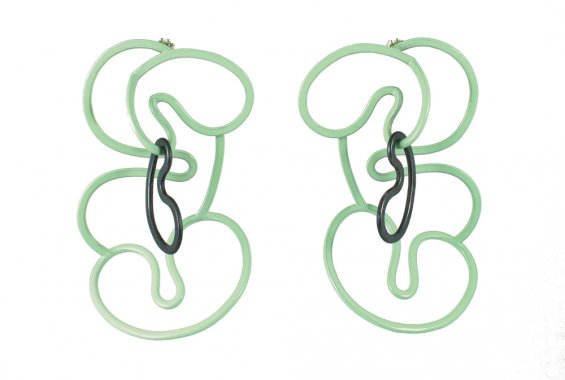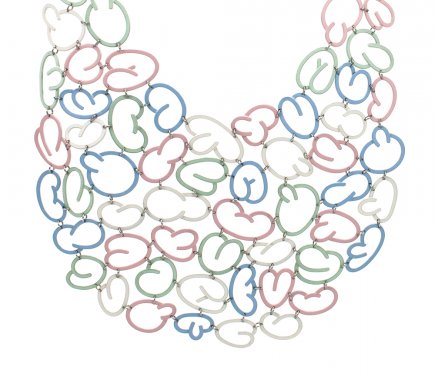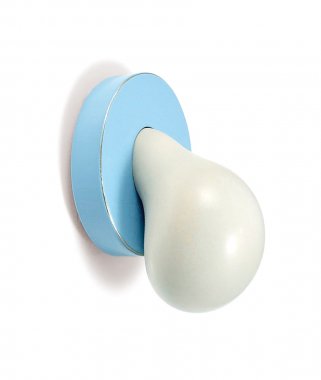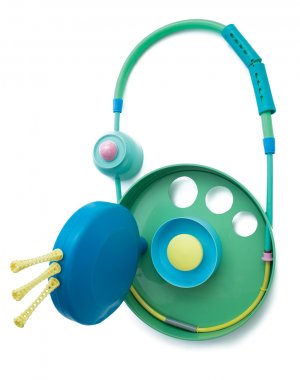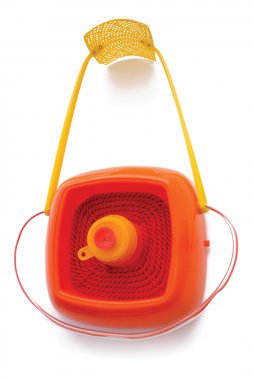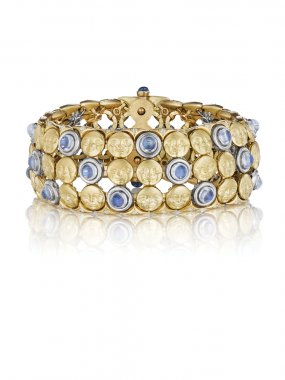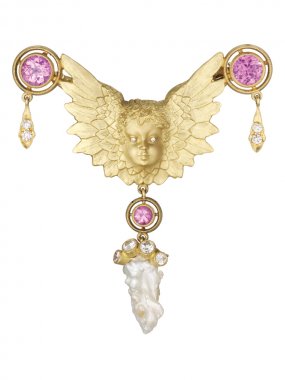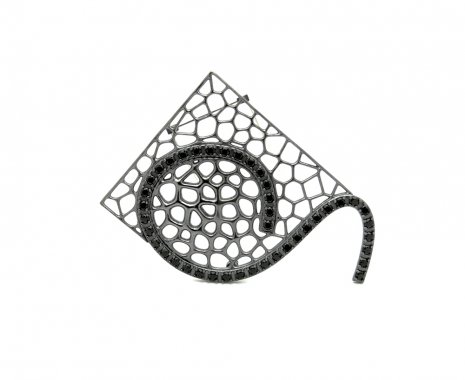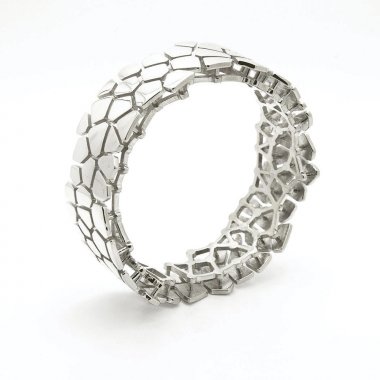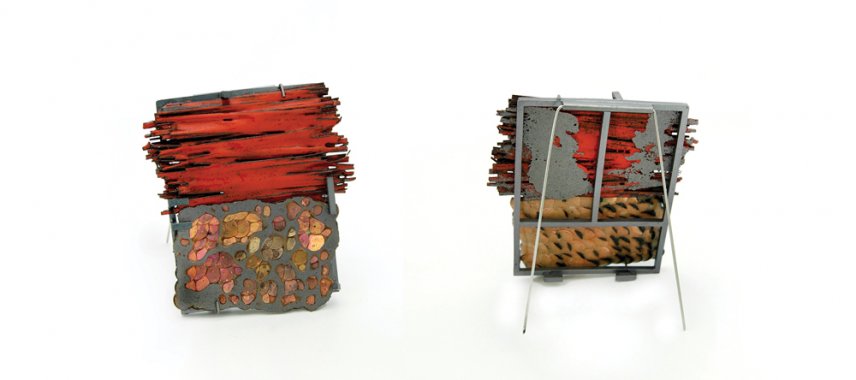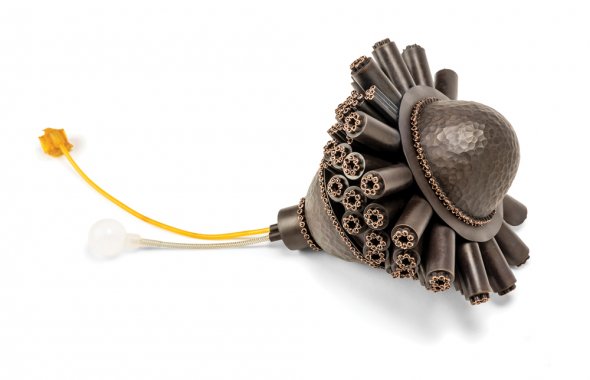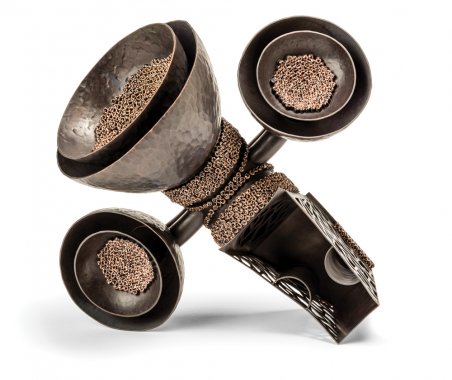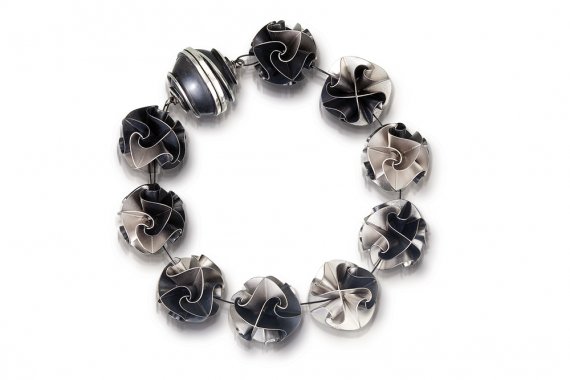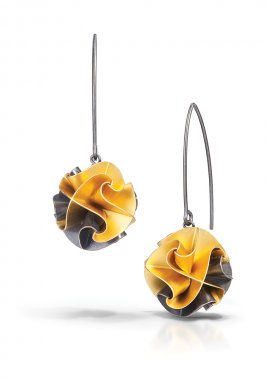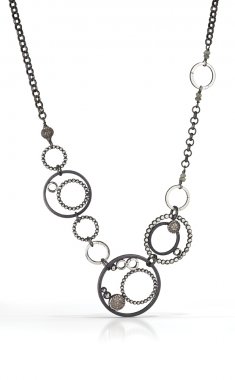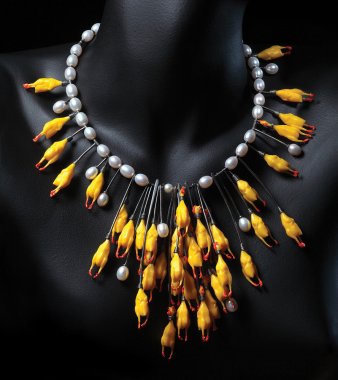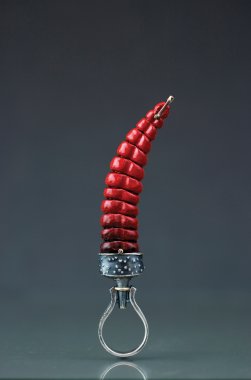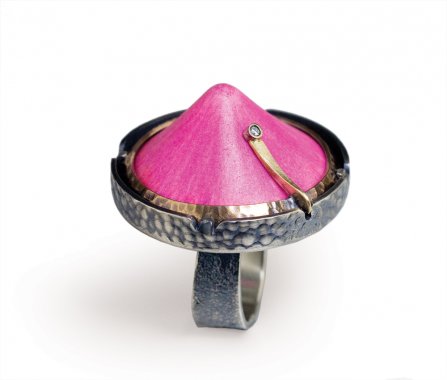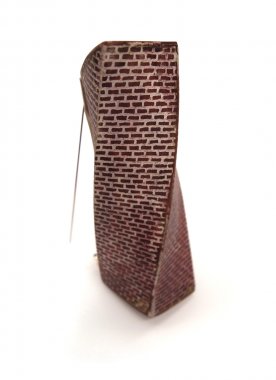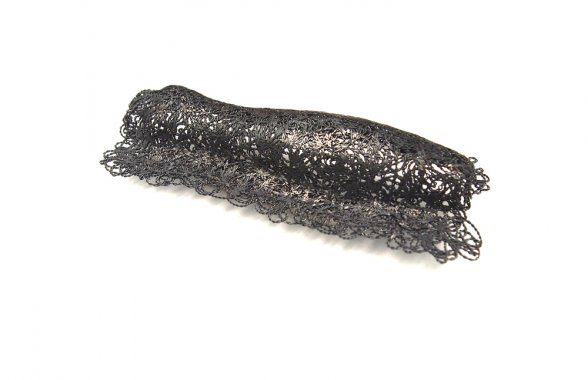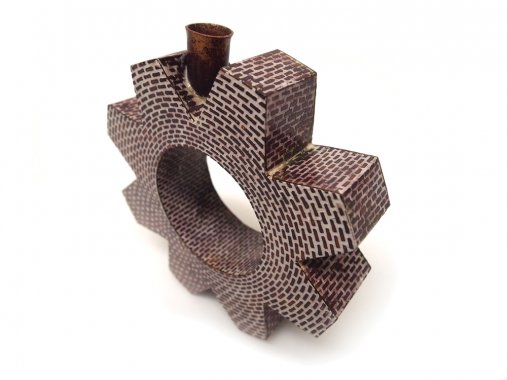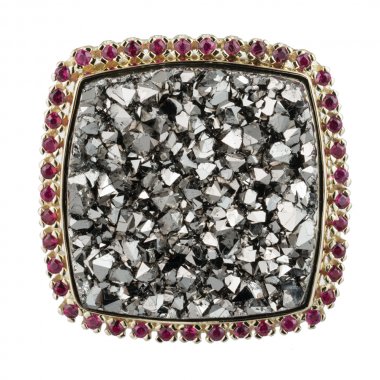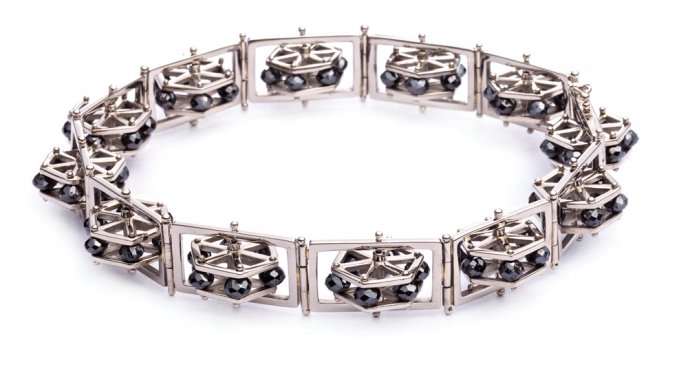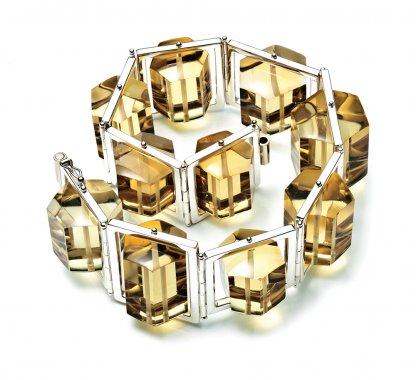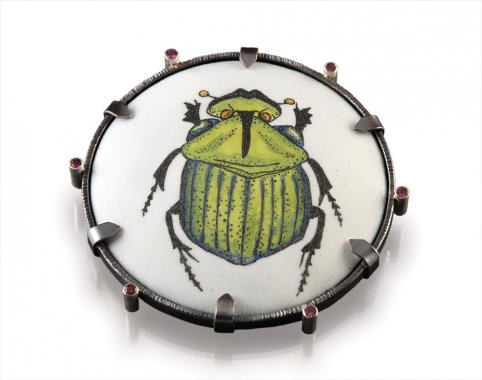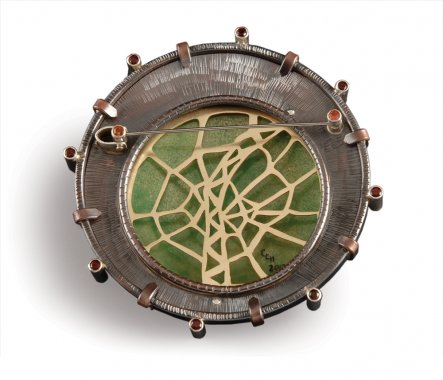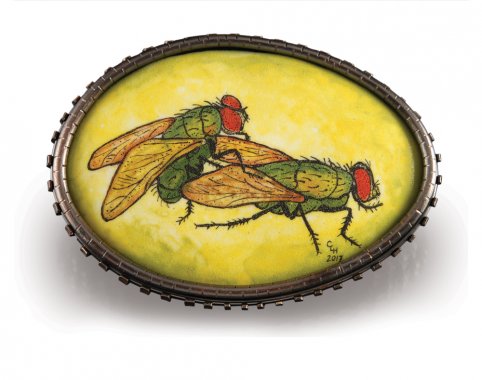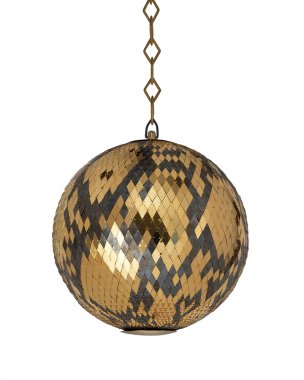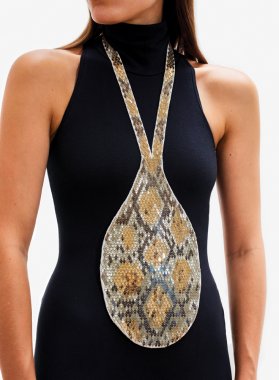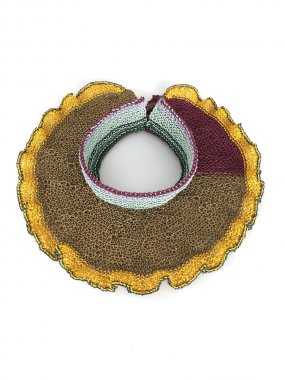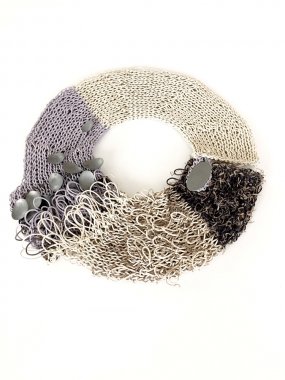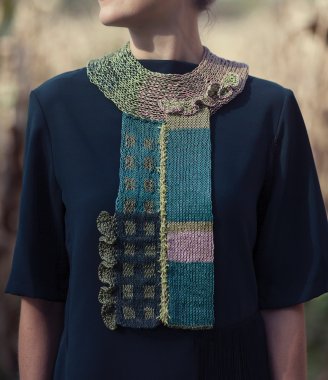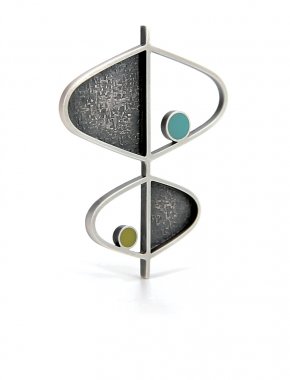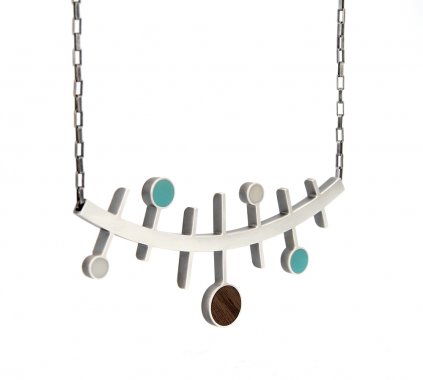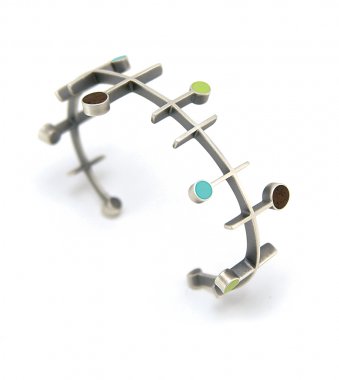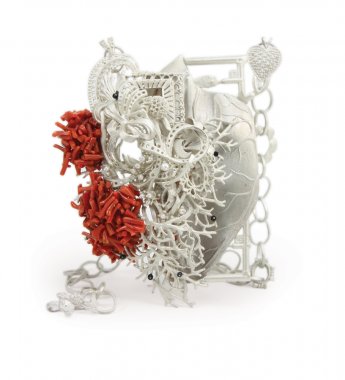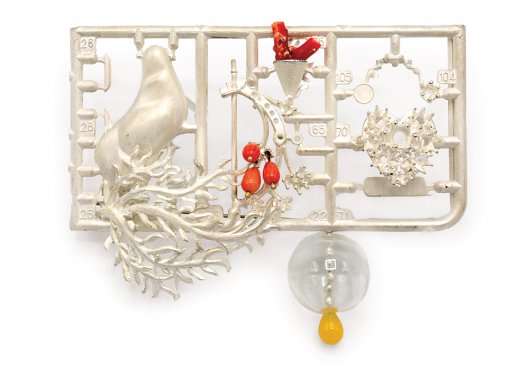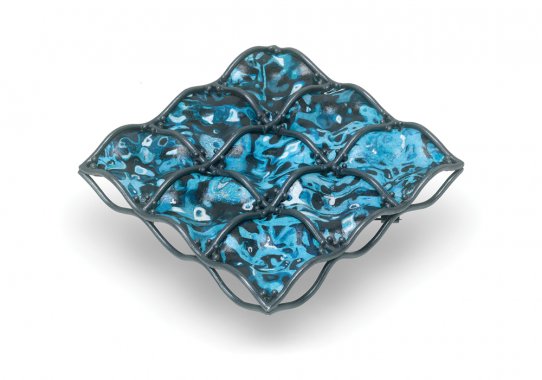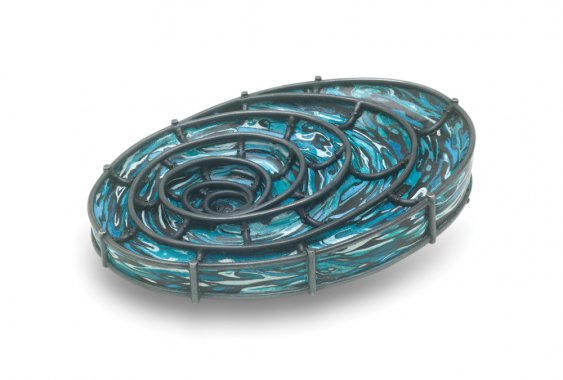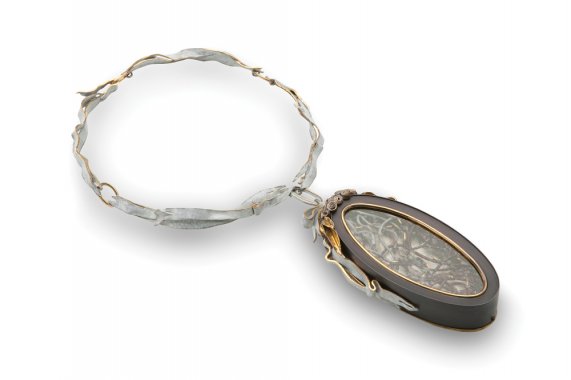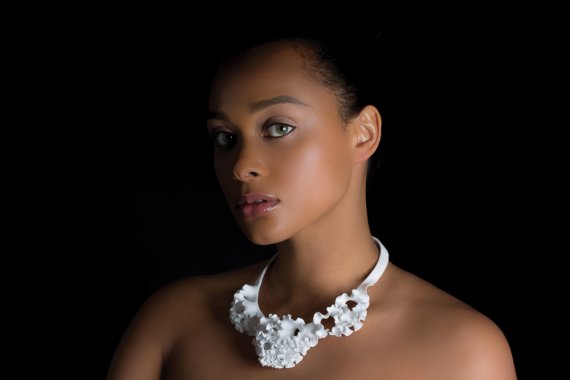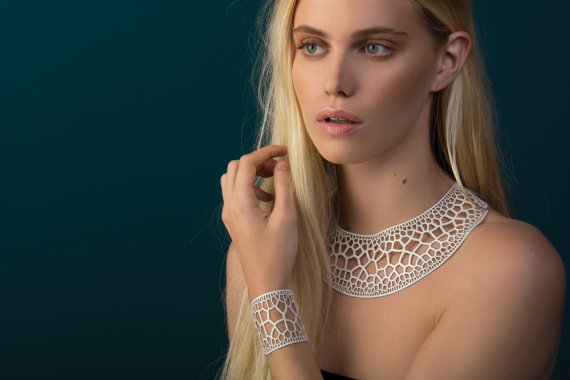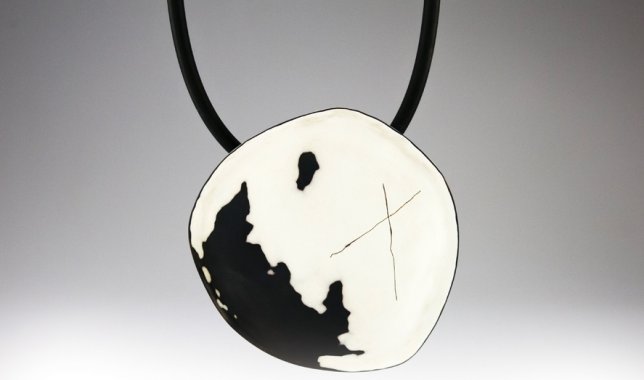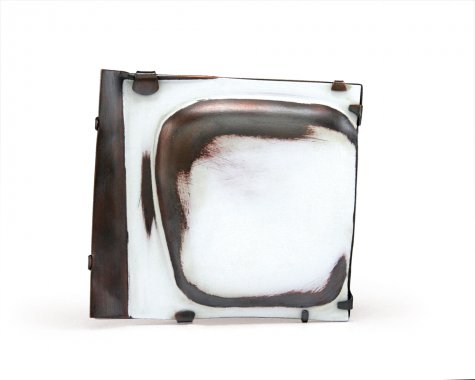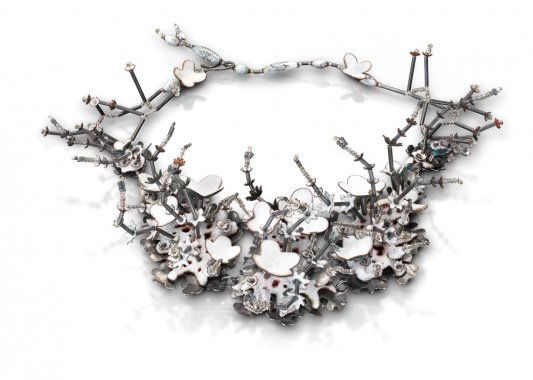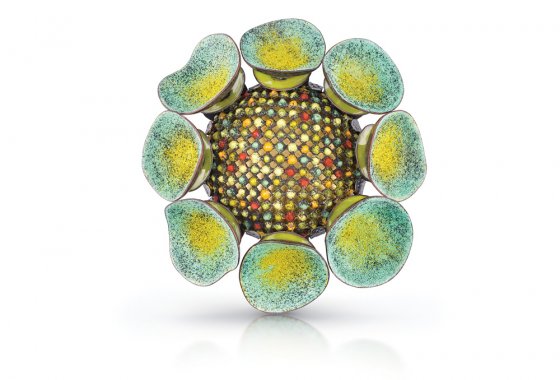Prime Time
Prime Time
The craft world often turns its gaze to up-and-comers or established masters – makers at opposite points in their journey. But what about those thriving in the mighty middle of that spectrum? For our jewelry issue, we asked Brigitte Martin, president of the Society of North American Goldsmiths and American Craft’s editor at large, to spotlight some of these makers. Martin defines mid-career as “the point in time when technical mastery comes easy, and a maker’s work is reliably sophisticated and well thought-out.” The 18 jewelry artists shown here vary in age and approach but are united in accomplishment. ~The Editors
Tyler Stoll, 30, Richmond, Virginia
Day job: Studio coordinator for metals, wood, glass, and fiber, Visual Arts Center of Richmond
Preferred materials: Powder-coated metal, castable materials
How he describes his work: “Cartoony, corporeal, bulbous, tactile.”
Why he makes jewelry: “I make work about bodies and enjoy the conversations that develop when it is worn as jewelry.”
Brigitte’s take: “Think powder-coating, concrete, and jewelry don’t mix? Think again. This new kid on the block is showing us how it’s done.”
Katie Kameen, 31, Richmond, Indiana
Day job: Visiting assistant professor of art, Earlham College
How she describes her work: “Spontaneous, vibrant, retro, resourceful, evocative, whimsical.”
Preferred materials: Currently: colorful, lightweight midcentury plastics and 3D-printed PLA – “but my first love was die-formed and powder-coated copper.”
Why she makes jewelry: “I am interested in the relationship objects have to our bodies; we constantly interact with things and therefore become desensitized to their physical attributes, so wearing these objects on our bodies reminds us of our reliance on them.”
Brigitte’s take: “Kameen creates large-scale, colorful objects and jewelry – mostly from discarded everyday plastics – that are visually situated somewhere between the 1950s and today.”
Anthony Lent, 69, Philadelphia
Day job: Full-time studio artist, former teacher at the Fashion Institute of Technology
How he describes his work: “Dreamlike, humanistic, whimsical, from an alternate universe.”
Preferred materials: Platinum, gold, silver, exotic pearls
Why he makes jewelry: “I could not find a purpose for the sculptural object – a statue serves no function other than being a statue – but earrings have a job to perform. Also, I like the microscopic world.”
Brigitte’s take: “Based loosely on the anatomical illustrations of Leonardo da Vinci, Lent’s solid-gold skull rings and bone-shaped bracelets hover somewhere between realism and surrealism. This work has all the hallmarks of traditional fine jewelry, but reducing it to that term would miss the mark.”
Arthur Hash, 41, Providence, Rhode Island
Day job: Assistant professor, jewelry and metalsmithing, Rhode Island School of Design
How he describes his work: “Iteration, simulacrum, transmutation, systematize, ballast, transceiver.”
Preferred materials: Currently, Hash loves using faceted stones and precious metals, but he has always loved enamel and the resins used in 3D printing.
Why he makes jewelry: “Jewelry as a platform opens new avenues of inquiry that wouldn’t be possible with static work.”
Brigitte’s take: “Water-jet cutting, 3D scanning, CNC routing, and rapid prototyping: Hash has been at the forefront of incorporating the newest technology into jewelry for as long as I can remember. And he’s a pretty damn good stone-setter, too.”
Holland Houdek, 32, Rochester, New York
Day job: Assistant professor and art gallery director, Nazareth College
How she describes herself: “Fire-wielding, hammer pounding, metal-sculpting, passionate woman artist.”
Preferred materials: Copper, medical devices and materials
Why she makes jewelry: “I make metal arts because I have to. I love the material and how I can manipulate it, and metallurgy and metalsmithing’s deep histories fascinate me.”
Brigitte’s take: “Not one to shy away from taboos, Houdek features silicone breast implants treated as if they were carved gemstones. The artist has worked closely with the medical industry and formed professional partnerships with the American Academy of Orthopedic Surgeons, MedWish International, and Cleveland Clinic, among others.”
Chihiro Makio, 41, Northampton, Massachusetts
Business name: 314studio
Day job: Mother of a 3-year-old
Preferred material: Silver
Why she makes jewelry: “It’s a perfect medium for a small-scale artist like me to express myself in.”
Brigitte’s take: “An established regular at national craft shows, this jeweler has a knack for showy, well-designed statement pieces. From those, she often picks a distinct design element and creates a smaller scale series around it.”
Andy Cooperman, 59, Seattle
Day job: Full-time studio artist; also lectures and teaches workshops, classes, and seminars
Three ways he describes his work: “All sorts of things made from all sorts of things; material-positive, craft-forward; from the gut, through the brain.”
Preferred materials: “Whatever rings my bell,” metallic (sterling, gold, bronze, and steel) or nonmetallic. “But I’m especially jazzed by counterintuitive materials like quills, snake rattles, plastic chickens, and Ping-Pong balls.”
Why he makes jewelry: “I like the portable, intimate, and concentrated scale of jewelry and how it can deliver big ideas in a grassroots sort of way.”
Brigitte’s take: “Humor and charm, technical finesse, a penchant for experimentation, and disarming honesty: Cooperman wears his heart on his sleeve.”
Sharon Massey, 41, Homer City, Pennsylvania
Day job: Assistant professor of jewelry and metals, Indiana University of Pennsylvania
How she describes her work: “Ever-evolving, tactile, dimensional.”
Preferred materials: Enamel, steel, silver, copper
Why she makes jewelry: “The accessibility and portability of jewelry as an art form offers so much potential, and I love working with metal and continuously experimenting with the medium.”
Brigitte’s take: “Reminding us of an industrial past that almost doesn’t exist anymore, Massey keeps history alive through geometric shapes that resemble the brick-based architecture found in her everyday surroundings.”
Patricia Madeja, 56, West Islip, New York
Day job: Jewelry program coordinator, Pratt Institute
How she describes her work: “Elegantly playful, architectural, geometric, kinetic, engineered.”
Preferred materials: Sterling silver, 14k and 18k gold, precious stones, pearls
Why she makes jewelry: “I fell in love with making jewelry in college and found the scale, attention to detail, and magic of the materials a perfect fit for my creative nature and 3D sensibilities.”
Brigitte’s take: “A photo cannot convey the magnificence of Madeja’s work. With off-the-charts fabrication skills, she produces kinetic jewelry with precious metals and gemstones that has to be touched to be believed.”
Charity Hall, 39, Blacksburg, Virginia
Day job: Full-time studio artist
How she describes her work: “Enameling for the love of insects.”
Preferred materials: Enamel, oxidized copper, semi-precious and non-precious gemstones
Why she makes jewelry: “I make jewelry to celebrate the diversity of insects while reflecting upon our competing aversion and allure to them.”
Brigitte’s take: “This biological surveyor and botanist turned her attention to jewelry full-time after attending a ring-making workshop at Penland School of Crafts. Critters never looked so good.”
Mallory Weston, 31, Philadelphia
Day job: Adjunct professor, Rowan University, Towson University, University of the Arts, Moore College of Art and Design
How she describes her work: “Serpents, symbols, seduction, and stitching.”
Preferred materials: “The palette that the spectrum of metals has to offer”; leather, fur, cotton, raw silk. A recent series used carved fluorescent minerals, which “glow in vivid neon colors under ultraviolet light.”
Why she makes jewelry: “I love the intimacy of the medium through the close connection the maker has with the materials and through the bond that forms between a wearer and their beloved piece of jewelry.
Brigitte’s take: “While remaining in a solid state, can metal move like a fabric? Yes.”
Brooke Marks-Swanson, 40, South Bend, Indiana
Day job: Full-time studio artist
How she describes her work: “Textile, tactile, fantastical.”
Preferred materials: Knit leather, fiber, oxidized silver
Why she makes jewelry: “I want to make our connection to the changing landscape visible through the intimacy of jewelry.”
Brigitte’s take:“Marks-Swanson’s knitted leather jewelry reminds you of agricultural landscapes and rock formations. Her careful composition of soft and hard materials renders her work instantly recognizable.”
Matthew Smith, 48, Asheville, North Carolina
Day job: Full-time studio artist
How he describes his work: “Modern, graphic, concise.”
Preferred materials: Sterling silver, wood, resin
Why he makes jewelry: “I enjoy creating compact and accessible objects that develop an intimate connection with their owners.”
Brigitte’s take: “Originally a furniture maker, this artist creates mod, understated jewelry that combines wood and metal in perfect unity.”
Mary Hallam Pearse, 49, Athens, Georgia
Day job: Associate professor of art, University of Georgia
How she describes her work: “Cast, flirtatious, desire.”
Preferred material: Silver
Why she makes jewelry: “It’s involved in so many humanizing exchanges.”
Brigitte’s take: “Desire, seduction, adornment, and ornamentation are the main themes of Pearse’s work. Can we add humor and playfulness? And pearls. Lots of pearls.”
Diane Falkenhagen, 63, Galveston Island, Texas
Day job: Full-time studio artist
How she describes her work: “An eccentric alliance of material and content; evocative imagery meets fabricated metal forms.”
Preferred materials: Non-ferrous metals, pigments, plastics, other alternative materials
Brigitte’s take: “In my dreams, architecture looks like this. Classy and timeless work.”
Jessica Rosenkrantz and Jessie Louis-Rosenberg
35 and 31, Somerville, Massachusetts
Business name: Nervous System
Day job: The duo works full time at their design studio, where they make jewelry, laser-cut jigsaw puzzles, slipcast porcelain, and 3D-printed lamps, as well as develop software. Rosenkrantz also teaches design at Massachusetts Institute of Technology.
How they describe their work: “Generative designs inspired by nature.”
Preferred materials: 3D-printed nylon, silicone rubber, stainless steel
Why they make jewelry: “Jewelry is a vehicle for us to research, express, and share complex ideas about science and technology.”
Brigitte’s take: “Rosenkrantz and Louis-Rosenberg work at the intersection of science, art, and technology. What can you expect from this duo? Pretty much everything, from a fully 3D-printed dress to intricate, geologically inspired puzzles. They never disappoint.”
Jim Bové, 51, Washington, Pennsylvania
Day job: Associate professor, California University of Pennsylvania
How he describes his work: “Minimalist with a touch of abstract expressionism.”
Preferred materials: Copper, silver, industrial auto primer
Why he makes jewelry: “Jewelry is a very personal art form. The wearer gets to intimately explore the artwork while their body becomes the gallery that exhibits it.”
Brigitte’s take: “When in need of a quiet expression in our noisy world, look no further than Jim Bové’s work. His brooches may appear unembellished, yet there is nothing plain about them. Bové is a master of the art of restraint.”
Wendy McAllister, 68, Baltimore
Day job: Full-time studio artist; spent 20 years as a ceramist before finding jewelry
How she describes her work: “Colorful, vibrant, exuberant, heartfelt, one-of-a-kind, sculptural.”
Preferred materials: Vitreous enamels, copper, sterling silver
Why she makes jewelry: “I am seduced by the endless array of forms, clashing colors, and underlying geometry in the natural world, and I feel driven to explore that through my work.”
Brigitte’s take: “With a keen sense of color, McAllister is one of the reigning queens of enamel.”
